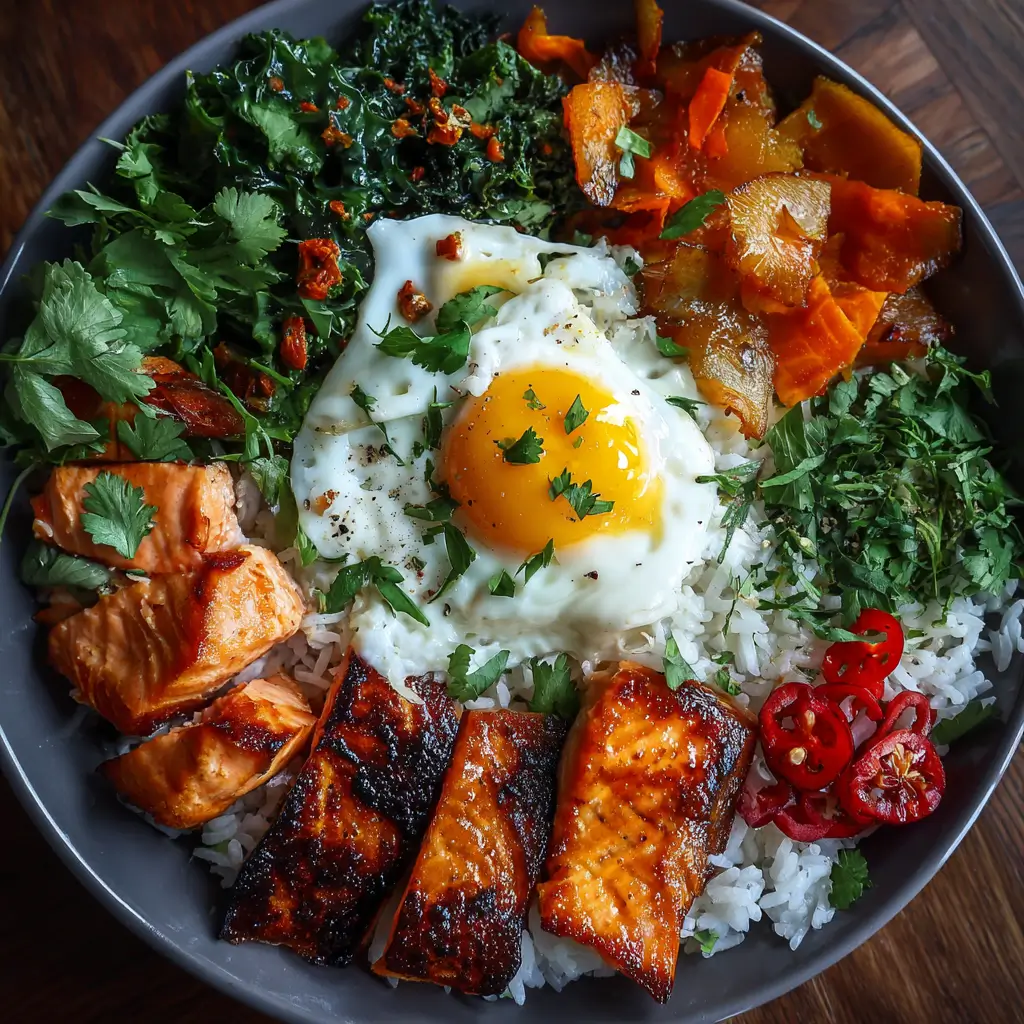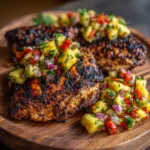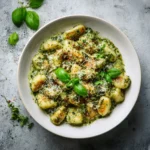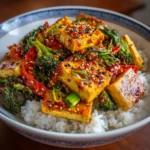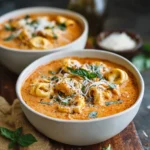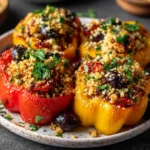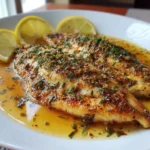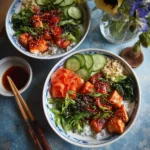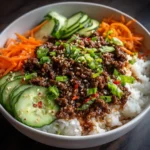Introduction
The Salmon Rice Bowl is a vibrant, nutritious, and satisfying meal that combines the rich, buttery flavor of salmon with fluffy rice, fresh vegetables, and savory sauces. Originating from the fusion of Japanese and Western culinary traditions, this bowl has become a staple in modern health-conscious diets due to its balanced macronutrients, ease of preparation, and adaptability to various taste preferences. Whether you’re looking for a quick weeknight dinner, a meal prep favorite, or a post-workout dish, the Salmon Rice Bowl delivers both comfort and nourishment in one delicious package. Packed with omega-3 fatty acids, lean protein, fiber-rich vegetables, and complex carbohydrates, it’s no wonder this dish has gained popularity across homes, cafes, and restaurants worldwide.
The History
The concept of the rice bowl, known as “donburi” in Japan, dates back centuries and traditionally features cooked rice topped with meat, fish, or vegetables simmered in flavorful sauces. Classic variations include katsudon (breaded pork cutlet), oyakodon (chicken and egg), and unadon (eel). The Salmon Rice Bowl, while not a traditional donburi, draws heavy inspiration from these time-honored dishes, incorporating elements of Japanese cooking techniques such as searing, marinating, and glazing.
In recent decades, with the global rise in sushi culture and increased appreciation for healthy seafood, salmon became a popular protein choice in Western cuisine. Chefs and home cooks began experimenting by combining grilled or seared salmon with rice bowls enhanced by ingredients like avocado, edamame, seaweed, and miso-based dressings. This evolution led to the modern Salmon Rice Bowl—a hybrid creation reflecting globalization, dietary trends, and the desire for colorful, nutrient-dense meals served in a single bowl. Today, it’s a celebrated dish in grain bowl movements, meal delivery services, and clean-eating communities.
Ingredients Breakdown
The beauty of the Salmon Rice Bowl lies in its layered components, each contributing unique textures, flavors, and nutritional benefits:
- Salmon Fillet: Rich in omega-3 fatty acids, high-quality protein, vitamin D, and B vitamins. Opt for wild-caught salmon when possible for higher nutrient density and lower environmental impact.
- Rice: Traditionally white sushi rice, but brown rice, jasmine, basmati, or even cauliflower rice can be used for varied textures and glycemic responses. Provides complex carbohydrates for sustained energy.
- Avocado: Adds creaminess and heart-healthy monounsaturated fats. Also contributes fiber, potassium, and vitamin E.
- Edamame: Young soybeans that are a complete plant-based protein source and rich in folate, vitamin K, and fiber.
- Cucumber: Offers crunch and hydration, with a mild flavor that complements the richness of salmon.
- Carrots: Shredded or julienned for sweetness and color; high in beta-carotene, which supports eye health.
- Green Onions: Provide a sharp, aromatic bite and are rich in antioxidants and vitamin C.
- Sesame Seeds: Add nutty flavor and a boost of calcium, magnesium, and healthy fats.
- Nori (Seaweed Sheets): Traditional Japanese ingredient offering umami flavor and iodine, essential for thyroid function.
- Soy Sauce or Tamari: For seasoning; tamari is gluten-free and often less salty. Contains fermented soybeans rich in beneficial compounds.
- Rice Vinegar: Used in rice seasoning; helps regulate blood sugar and adds tanginess.
- Maple Syrup or Honey: Natural sweeteners that balance acidity in marinades and dressings.
- Ginger and Garlic: Aromatic ingredients with anti-inflammatory and immune-supportive properties.
- Olive Oil or Toasted Sesame Oil: Healthy fats that enhance flavor and aid in the absorption of fat-soluble vitamins.
Step-by-Step Recipe
- Cook the Rice: Rinse 1 cup of rice under cold water until the water runs clear. Combine with 1¾ cups water in a saucepan. Bring to a boil, then reduce heat to low, cover, and simmer for 15–18 minutes (or according to package instructions). Remove from heat and let sit covered for 10 minutes. Fluff with a fork. Stir in 1 tablespoon rice vinegar, 1 teaspoon sugar, and ½ teaspoon salt for a sushi-style finish if desired.
- Prepare the Salmon Marinade: In a bowl, whisk together 2 tablespoons soy sauce, 1 tablespoon olive oil, 1 tablespoon maple syrup, 1 minced garlic clove, and 1 teaspoon grated fresh ginger. Place two salmon fillets (about 6 oz each) in a shallow dish and pour marinade over them. Cover and refrigerate for 20–30 minutes (do not exceed 1 hour to avoid texture changes).
- Marinate and Cook the Salmon: Preheat oven to 400°F (200°C). Remove salmon from marinade (discard used marinade) and place on a parchment-lined baking sheet. Bake for 12–15 minutes, or until the internal temperature reaches 145°F and the flesh flakes easily. Alternatively, pan-sear over medium-high heat for 4–5 minutes per side for a crispier exterior.
- Prep the Vegetables: While the salmon cooks, slice ½ avocado, dice ½ cucumber, shred 1 carrot, and chop 2 green onions. Steam ½ cup shelled edamame for 3–5 minutes until tender. Set aside.
- Make the Dressing (Optional): Whisk together 1 tablespoon tahini, 1 tablespoon soy sauce, 1 teaspoon sesame oil, 1 teaspoon rice vinegar, 1 teaspoon honey, and 1 teaspoon water until smooth. Adjust consistency with more water if needed.
- Assemble the Bowls: Divide the cooked rice between two large bowls. Top with flaked salmon, avocado slices, cucumber, carrots, edamame, and green onions. Sprinkle with sesame seeds and crumbled nori. Drizzle with dressing just before serving.
Tips
- Don’t Overcook the Salmon: Use a meat thermometer to ensure precision. Overcooked salmon becomes dry and loses its delicate texture.
- Brighten the Rice: Seasoning the rice with rice vinegar, sugar, and salt enhances flavor and mimics sushi rice, elevating the overall bowl.
- Prep Ahead: Cook rice and chop vegetables in advance for quick assembly during busy days. Store components separately in airtight containers for up to 3 days.
- Boost Umami: Add a splash of mirin or a dash of fish sauce to the marinade for deeper savory flavor.
- Toasting Sesame Seeds: Lightly toast sesame seeds in a dry pan over medium heat for 2–3 minutes until golden and fragrant—this intensifies their nutty taste.
- Use Fresh Ginger: Always grate fresh ginger rather than using powdered for a brighter, more aromatic flavor profile.
- Rest the Salmon: Let cooked salmon rest for 2–3 minutes before flaking to retain moisture.
- Customize Heat: Add sriracha, chili oil, or sliced jalapeños for a spicy kick.
Variations and Customizations
The Salmon Rice Bowl is highly adaptable based on dietary needs, cultural influences, and seasonal ingredients:
- Keto/Low-Carb Version: Replace rice with riced cauliflower or a bed of mixed greens. Increase healthy fats with extra avocado and olive oil.
- Vegan Option: Substitute salmon with marinated and baked tofu or tempeh. Use a plant-based glaze made from soy sauce, maple syrup, and liquid smoke for a smoky flavor.
- Mediterranean Twist: Swap soy sauce for lemon-tahini dressing, add cherry tomatoes, olives, and feta cheese, and use quinoa instead of rice.
- Pineapple-Glazed Salmon: Add diced pineapple to the marinade for a tropical twist. Pair with mango salsa and cilantro for a Caribbean flair.
- Sushi-Inspired Bowl: Include pickled ginger, wasabi, and imitation crab (optional) for a deconstructed sushi experience.
- Spicy Mayo Salmon: Mix 1 tablespoon mayonnaise with 1 teaspoon sriracha and drizzle over the salmon before serving.
- Breakfast Bowl: Top rice with a soft-poached egg, smoked salmon, scallions, and a drizzle of hollandaise or ponzu sauce.
- Grain Alternatives: Try farro, barley, freekeh, or wild rice blends for different textures and nutrient profiles.
- Add Fermented Foods: Kimchi or sauerkraut can introduce probiotics and tangy depth to the bowl.
Health Considerations and Nutritional Value
The Salmon Rice Bowl is a nutritionally balanced meal that supports heart health, brain function, and metabolic wellness. Here’s a breakdown of key benefits:
- Omega-3 Fatty Acids: Found abundantly in salmon, these essential fats reduce inflammation, support cognitive function, and may lower the risk of heart disease.
- High-Quality Protein: Salmon provides all nine essential amino acids, aiding muscle repair and satiety.
- Fiber-Rich Vegetables: Carrots, cucumbers, edamame, and avocado contribute dietary fiber, promoting digestive health and stable blood sugar levels.
- Low Glycemic Index Options: Choosing brown rice or cauliflower rice helps manage insulin response, making this bowl suitable for diabetics or those monitoring carbohydrate intake.
- Antioxidants and Phytonutrients: Colorful vegetables deliver vitamins A, C, and K, along with lutein and zeaxanthin for eye health.
- Healthy Fats: Avocado and olive oil provide monounsaturated fats that support cholesterol balance and hormone production.
- Iodine and Trace Minerals: Nori seaweed is a natural source of iodine, crucial for thyroid regulation.
Nutritional Estimate (per serving, with brown rice and standard toppings):
- Calories: ~650–750
- Protein: 35–40g
- Fat: 25–30g (mostly unsaturated)
- Carbohydrates: 60–70g
- Fiber: 8–10g
- Sodium: 700–900mg (can be reduced with low-sodium soy sauce)
Note: Mercury content in salmon is generally low, especially in wild-caught varieties like sockeye or coho. Pregnant women and young children can safely consume 2–3 servings per week as recommended by the FDA.
Ingredients
- 1 cup uncooked rice (white, brown, or sushi rice)
- 2 (6 oz) salmon fillets, skin-on or skinless
- 2 tablespoons soy sauce (or tamari for gluten-free)
- 1 tablespoon olive oil
- 1 tablespoon pure maple syrup
- 1 garlic clove, minced
- 1 teaspoon fresh ginger, grated
- 1 ripe avocado, sliced
- ½ cucumber, diced or thinly sliced
- 1 medium carrot, shredded or julienned
- ½ cup shelled edamame, steamed
- 2 green onions, thinly sliced
- 1 tablespoon sesame seeds (white or black)
- 1 sheet nori, cut into thin strips or crumbled
- 1 tablespoon rice vinegar
- 1 teaspoon sugar (optional)
- ½ teaspoon salt
- For Dressing: 1 tbsp tahini, 1 tbsp soy sauce, 1 tsp sesame oil, 1 tsp honey, 1 tsp water
Directions
- Start by cooking the rice. Rinse thoroughly, then combine with 1¾ cups water in a pot. Bring to a boil, reduce heat, cover, and simmer for 15–18 minutes. Remove from heat and let stand for 10 minutes. Fluff and season with rice vinegar, sugar, and salt. Set aside.
- In a small bowl, prepare the marinade: mix soy sauce, olive oil, maple syrup, garlic, and ginger. Place salmon fillets in a container and coat evenly with marinade. Marinate in the refrigerator for 20–30 minutes.
- Preheat oven to 400°F (200°C). Line a baking sheet with parchment paper. Remove salmon from marinade and place on the sheet. Discard leftover marinade.
- Bake salmon for 12–15 minutes, or until opaque and flaky. Alternatively, sear in a hot skillet with a little oil for 4–5 minutes per side.
- While salmon cooks, prepare vegetables: slice avocado, dice cucumber, shred carrot, steam edamame, and chop green onions.
- Make the dressing by whisking together tahini, soy sauce, sesame oil, honey, and water until smooth. Add more water if too thick.
- Assemble bowls: divide rice between two large bowls. Top with flaked salmon, avocado, cucumber, carrot, edamabe, and green onions. Sprinkle with sesame seeds and nori.
- Drizzle with dressing just before serving. Serve warm or at room temperature.
FAQ
Can I use frozen salmon?
Yes, frozen salmon works well. Thaw it in the refrigerator overnight before marinating and cooking for best results.
How long can I store leftovers?
Cooked Salmon Rice Bowls can be stored in airtight containers in the fridge for up to 3 days. Keep dressing separate to prevent sogginess.
Is this recipe safe for pregnant women?
Yes, salmon is safe and recommended during pregnancy. Ensure it’s fully cooked to 145°F and sourced responsibly to minimize mercury exposure.
Can I make this ahead for meal prep?
Absolutely. Cook rice, prepare veggies, and cook salmon in advance. Assemble bowls just before eating or store components separately.
What can I substitute for soy sauce?
Coconut aminos offer a soy-free, lower-sodium alternative with a slightly sweeter taste.
Can I grill the salmon?
Yes! Grilling adds a smoky flavor. Grill over medium heat for 4–6 minutes per side, depending on thickness.
Are there sustainable salmon options?
Look for MSC-certified or ASC-labeled salmon. Wild-caught Alaskan salmon is often considered one of the most sustainable choices.
Summary
The Salmon Rice Bowl is a wholesome, flavor-packed meal that harmonizes rich salmon, tender rice, and crisp vegetables with umami-rich sauces. Easy to customize and ideal for meal prep, it’s a nutritious powerhouse perfect for any day of the week.
